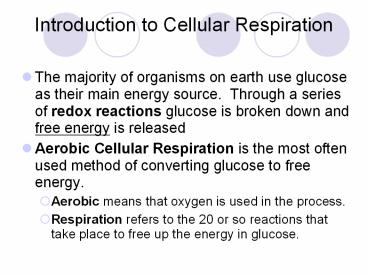Introduction to Cellular Respiration PowerPoint PPT Presentation
1 / 13
Title: Introduction to Cellular Respiration
1
Introduction to Cellular Respiration
- The majority of organisms on earth use glucose as
their main energy source. Through a series of
redox reactions glucose is broken down and free
energy is released - Aerobic Cellular Respiration is the most often
used method of converting glucose to free energy. - Aerobic means that oxygen is used in the process.
- Respiration refers to the 20 or so reactions that
take place to free up the energy in glucose.
2
Oxidation of Glucose
- C6H12O6 6O2 ? 6H2O 6CO2
- Oxygen oxidizes the C-H in glucose in two ways
- The 12 H are broken away to form 6 H2O, the 6 C
to form 6 CO2. - A C-H bond is non-polar, the electrons are
equally shared - In water and carbon dioxide the electrons are
drawn closer to oxygen, therefore H is oxidized
(LEO).
3
Oxidation of Glucose in the Lab
- Oxygen and glucose are stable molecules. They do
not readily react. - Lots of activation energy is needed (flame in lab
conditions). - 2870 kJ/mol energy released as heat and light.
4
Oxidation of Glucose in the Cell
- In the cell enzymes catalyze each reaction step,
reducing the activation energy and making it
easier for the cell to undergo aerobic cellular
respiration. - 3012 kJ/mol released. 34 is trapped in the
form of ATP. The rest is lost as heat and light.
5
Aerobes and Anaerobes
- Oxygen is not the only oxidizing agent at the end
of the respiration process, other molecules such
as NO2, SO4, CO2, and Fe3 are used in some forms
of bacteria to help undergo respiration (obligate
anaerobes) - Animals are obligate aerobes since they use
oxygen as their final oxidizing agent. - Organisms that can tolerate the presence and
absence of oxygen are called facultative aerobes
(mostly bacteria).
6
Aerobic Respiration
- In aerobic respiration there are three main
goals - break the bonds of glucose freeing the carbon to
make CO2 - break the bonds of glucose freeing H to form
water - to trap as much free energy as possible in the
form of ATP. - The entire process occurs in 4 main stages
Glycolysis, Pyruvate Oxidation, Krebs Cycle and
the Electron Transport Chain (Figure 1 on page 94)
7
GLYCOLYSIS
- First 10 reactions of cellular respiration
- Name means sugar-splitting
- It occurs in the cytoplasm and is anaerobic.
- Glycolysis is thought to have been the earliest
form of energy metabolism. - Each reaction is catalyzed by a specific enzyme.
- (Figure 11, page 98, handouts).
8
Glycolysis Pathway
9
Steps in Glycolysis Steps 1-5
- Two ATP are used (step 1 and step 3). This
primes glucose for cleavage in steps 4 and 5.
10
Steps 4 and 5
- Fructose 1, 6-biphosphate is split into DHAP
(dihydroxyacetone phosphate) and G3P
(glyceraldehyde 3-phosphate) and immediately the
enzyme isomerase changes DHAP into G3P.
11
Steps 6 through 10
- Steps 6 through 10 happen twice (one for each
molecule of G3P). - In step 6, NAD is reduced to NADH H
- NAD is an electron carrier. Each NAD removes
2H and 2e- - it will transfer the electrons to another
reaction later in cellular respiration (the ETC)
12
Steps 7-10
- Step 7 G3P is converted into PEP. Two ATP
molecules are produced by substrate level
phosphorylation. - Step 10 Phosphoenolpyruvate (PEP) is converted
into pyruvate Two ATP produced by
substrate-level phosphorlyation. - Net reaction
- Glucose 2ADP 2P 2NAD --gt 2 pyruvate 2ATP
2NADH 2H
13
Substrate Level Phosphorylation
- Glycolysis produces 2.1 of the entire free
energy of glucose in aerobic cellular respiration
by Substrate-Level Phosphorylation - The formation of ATP directly in an
enzyme-catalyzed reaction. A phosphate
containing compound transfers its phosphate group
to ADP (forming ATP) directly on an enzyme.

